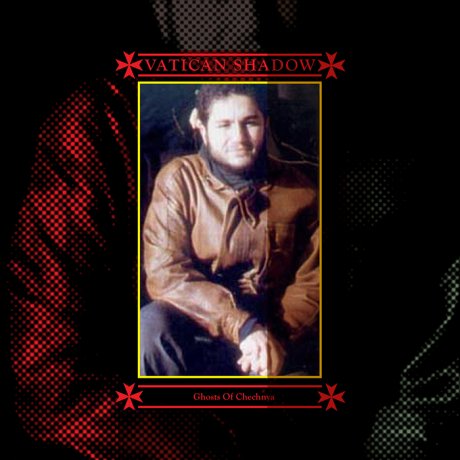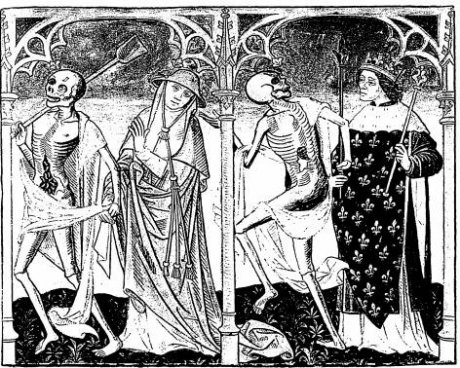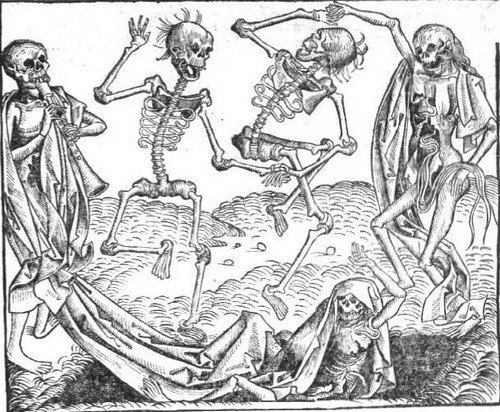We celebrate the end of the year the only way we know how: through lists, essays, and mixes. Join us as we explore the music and films that helped define the year. More from this series
Truculentus, Evermore
Death has always been both simultaneously feared and celebrated. Despite its impending, indiscriminate nature, death grips the imagination and manipulates social norms, reshuffling furniture inside the mind, toppling concepts of awareness on a plethora of existential levels, and realigning aspiration for artistic construction. Indeed, death has infested creativity worldwide. World events, personal experiences, and ravenous outbreaks that cause such inspiration have the potential to trigger shifts in the appreciation of works disseminated across an encompassing array of forms; from sculpture, graffiti, and shrine arrangement to pottery, origami, and music. A key issue at stake here is the expressive value of craft pertaining to deathly themes, and it is through discussing its representation via parafocal lenses of the macabre — the ghastly and horrifying — that I think is worthy of investigation, especially in a year in which death has continued to be such a central focus in the arts.
But how can that be measured when there is no means of quantifying an enthusiasm for such discourse throughout media output in a single year? Particularly when identifying exactly what “media” constitutes has become so awkward, from subverted news broadcasts about anti-Islamic films that invoked horrific religious rebuke, to the very content of those stories channeled through a range of different platforms that encompassed both individual and multinational distribution points. Circulation formats aside, a persistent fascination for death has ceased to dwindle as a consequence of technological development or the indirect, quasi-communication strategies that allow for terminological redefinition to continue, and the 37,000+ search results for “funeral” on Instagram encapsulate a number of biting indicators.
In the music world, the new year was christened by a bold reenactment, an homage to one of the most grim and sorrowful compositions of the 20th century with unrelenting death and torture at its center. Krzysztof Penderecki’s Threnody to the Victims of Hiroshima was revisited in a collaboration between the Polish composer and Jonny Greenwood in a fascinating production that illustrated passionate sympathy through symphony, a mourning for the casualties of nuclear fallout. All the while, the very subject of nuclear proliferation occupied pertinent space in the headlines, as contenders battled diligently for their right to stand poised over a metaphorical button that could unleash similar situations elsewhere. The true extent of the damage, or even the value of such detriment, constantly hung in the balance of public debate, while at the same time, images of militants, insurgents, and soldiers splattered one of the year’s most prolific underground electronic artists’ album sleeves. Artwork that embraces the macabre tends to express an interest in death and decay on the artist’s behalf. As a focal point, it might be used to release tension or exemplify contemplation, allowing for factors that remain both inevitable and unknowable to creep into the audience’s line of vision.
 Cover art for Vatican Shadow’s “Ghosts of Chechnya”
Cover art for Vatican Shadow’s “Ghosts of Chechnya”
The films and music that chose to elaborate on death as a linchpin in 2012 were particularly common, making for a compelling springboard into discussion here on a number of issues, not only concerning warfare and politics, but also with regards to presence and atmosphere. That’s not to take matters of international significance lightly, but to stay as indiscriminate, trivial, and slapdash as the paintings that spurred this rather murky retrospective — from the heinous depths of Vatican Shadow, to the dismal and harrowing music of Locrian, Mamiffer, Penderecki and Greenwood. Along the way, visitation rights are also granted to Emmanuel Nunes, Josef Škvorecký, and Kaneto Shindo, three pioneers of bleak and abstract works adhering to macabre themes, who passed away earlier in 2012 — for their efforts contributed substantially to this ever morbid tapestry that has continued to spin uninterrupted since its most gruesome beginnings.
Death’s Unity Lies Not in Its Origins
In 1348, a trading ship arrived at Dorset after setting sale from Gascony. Along with its humble cargo, the vessel carried an abundance of fleas, xenopsylla chopis, contaminated with the Yersinia bacterium that instigated an outbreak of concentrated human infection and ultimately a pandemic, which claimed an estimated 450 million lives worldwide. Over the course of a hundred years or so, creative forms were implemented as a method of chronicling the events at hand in addition to bringing about a broader illustration of unity, through eternal rest, that was most iconically portrayed in the Danse Macabre. The concept, part of an artistic genre of The Middle Ages that depicted the universality of death, has been persistently recreated since its first portrayal in 15th-century France, but what the imagery fundamentally eludes to is the unquestionable impartiality of death. In its various incarnations, cadavers summon the old, the young, the rich, the powerful, and the poor, who are all called to take part in this posthumous ceremony, a jovial dance in the face of mortality that seals the fate of every living being.

Artistic works, particularly in painting at the time of the initial outbreak, ravenously documented scenes of lawless behavior, extreme licentiousness, and mass graves. Though there was little immediacy in capturing public imagination, death became a rampant subject through inventive expression that was a massive departure from the elaborate glory of Christ’s crucifixion towards austere visualizations that transcended into breakaway behavioral traits. Commemoration became a theme in the British Isles, while sadomasochism erupted throughout Germany and persecution took on assorted manifestations elsewhere in Europe. These reactions were by no means an upshot of expressive artistry, but an actual portrayal of the physical situations that governed during this devastating age. However, the art that blossomed as a consequence assumed radical steps in the way that death is depicted artistically, and it has not been the same since.
The images and music that thematically placate these subjects invoke a cacophony of emotional backlash, which varies as much as those 14th-century social retaliations to the plague itself. Penderecki’s Threnody is an enthralling example of this, not only because the original caption for his piece was “8’37″,” a title void of any affiliations of death, reminiscence, or anything at all other than timing, but because of the relationship the audience may have with the music now, as a classical arrangement responded to by Jonny Greenwood. The work ultimately embodies a tone similar to that of the British when the plague broke out, one of commemoration and remembrance. Penderecki named his already existing score after one of the most horrific atrocities committed in the 20th century, and though his arrangements may sound like an immediate sonic reaction to the bomb dropping, it was initially a project sought outside of those parameters, only to be renamed later. However, those piercing violin screeches could not be more appropriate for tackling the incident, and despite Greenwood’s responses being angled towards his appreciation for the composition and for the artist, they still conjure the most grim and glowering visualizations.
While commemoration and remembrance have the potential to bring about feelings of ire, remorse, and sympathy within a macabre framework, there still remains a fragile borderline between documentation and glorification. When a photograph of Nidal Malik Hasan is used as album art, darker territories are crossed, particularly when set among a backdrop of releases that also depict skewed pictures of war and violence. Dominick Fernow’s Vatican Shadow project is pitched as “music for assassins on the world-scale board game,” and although the cover for Kneel Before Religious Icons is not a direct exemplification of macabre imagery, it does call into question issues of taste and heroic virtue. The photographs indicate a dark humor, but carry a confident, provocative weight in an approach that remained consistent through the entirety of Vatican Shadow releases this year; from Iraqi Praetorian Guard to Ghosts of Chechnya to Ornamented Walls, these recordings have encompassed a desire to magnify enthusiasm for the rich, sinister techno Fernow produces through striking emotive aural chords while simultaneously encompassing themes of death and suffering in a pseudo-military context. Such methods capture the imagination in a fashion similar to techniques deployed in tugging on the strings of intrigue that are plucked by the mass media in channeling audience volumes: Whereas (independent) artists might use shocking and provocative visuals to draw attention or sell albums, world news entities employ similar tactics to sell commentary. When covering reports with political thriller twists, these factors are immediately embellished to pull greater statistics, and this is due to a holistic, otherwise untapped fascination for the macabre. These tactics achieve results, and 2012 was awash with tales that were capable of caressing these curiosities like a troubled stockbroker massaging his temples.
The Sacrament of Confirmation
For death to be incorporated effectively as a means of attracting interest, playful embellishment mutates into an essential component, regardless of any secondary objective, such as the by-proxy promotion of a side-project or the proposed restructuring of the Communist Party; much more is brought to the table with the anticipation of murder, corruption, and treachery. When it was uncovered that the British businessman Neil Heywood had in fact been poisoned while staying in Chongqing and that he had suspicious ties with the rising and reputable CCP all-star Bo Xi Lai, an investigation promptly ensued. The story was haphazardly discussed in the Chinese press, which operated as a mouthpiece for the global media who picked up and re-ran the findings of China Daily and CCTV 9. This grizzly ransacking of public image and reputation not only brought about the separation of Mr. Bo and his wife, Gu Kailai, but also saw the latter sentenced to death, while her husband is yet to be seen in public since his arrest. The dramatic nature of this narrative and the suspense it created was incredible when taking into account that the 10-year change around in government was successfully completed without any major disruption to the status quo, while a seeming Maoist resurgent was held behind bars and manhandled for corruption and murder charges.
We celebrate the end of the year the only way we know how: through lists, essays, and mixes. Join us as we explore the music and films that helped define the year. More from this series
